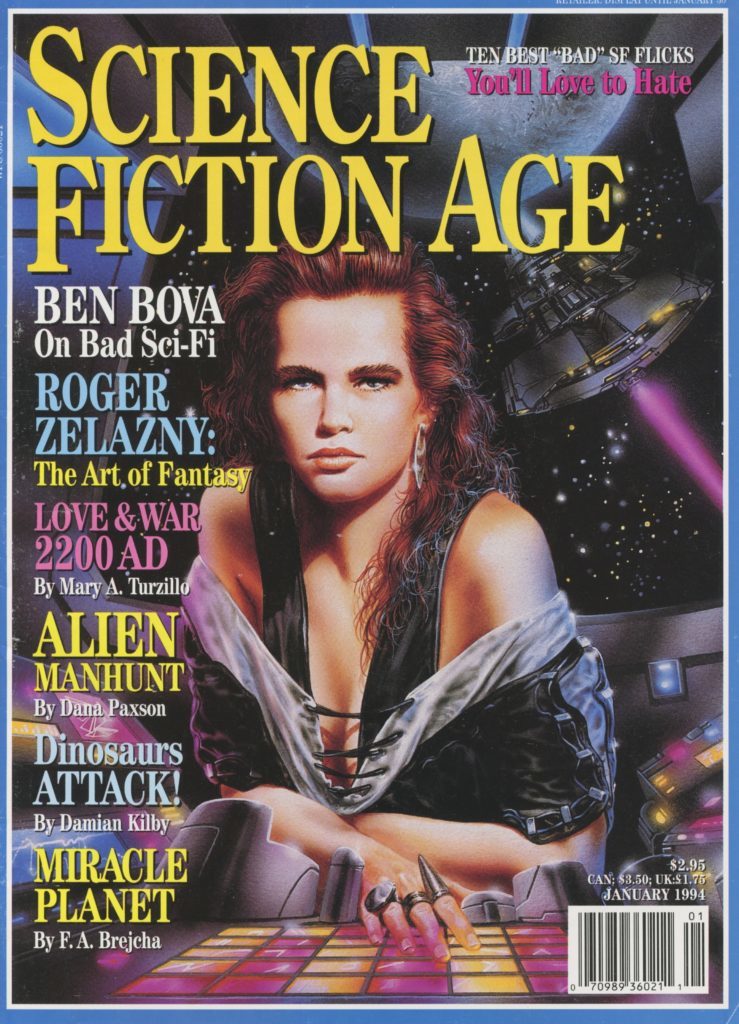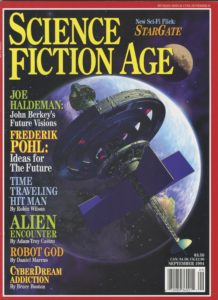(1) GWW TEAMS UP WITH WW. ComicsBeat spreads the word: “G. Willow Wilson and Cary Nord Are Your New WONDER WOMAN Creative Team”.
Dan DiDio revealed in the “DC Nation” portion of this week’s DC All Access video that award-winning writer G. Willow Wilson will be the new regular series writer on Wonder Woman. Wilson will team with artist Cary Nord following Steve Orlando’s forthcoming guest-arc. In the video, DiDio says that Wilson will be expanding on the concepts and ideas that initial Rebirth Wonder Woman writer Greg Rucka introduced in his year-long run on the series. The creative team’s first story will be titled “The Just War,” and will feature Wonder Woman facing off again with Ares while attempting to rescue a missing Steve Trevor.
On G. Willow Wilson’s site a headline says “The rumors were true”.
“I’m delighted to be writing such an iconic character as Wonder Woman and to be working with DC once again,” said Wilson. “With more than 75 years of history, Wonder Woman has a wealth of backstory and drama to draw from, and I look forward to putting a spin on Diana and her supporting cast that’s both new, yet familiar. It’ll be a challenge to do her justice, but I like a challenge and can’t wait to get started.”
(2) POOH MAP SETS RECORD. CNN has the story — “Winnie-the-Pooh original map illustration sells for record $570,000”.
The original drawing of the map that appears inside the cover of A.A. Milne’s beloved book “Winnie-the-Pooh” sold at a Sotheby’s auction for nearly $600,000 — a record for any book illustration.
The Hundred Acre Wood map is the work of E.H. Shepard, who was asked to illustrate the book in 1926. Sotheby’s valued the map between $130,000 and nearly $200,000 (or between £100,000 and £150,000), according to a news release from May announcing the sale.
The auction house described the drawing, which was unseen for 50 years, as “possibly the most famous map in children’s literature.”
#AuctionRecord: The original drawing of Winnie-the-Pooh’s Hundred Acre Wood sells for £430,000 to set new record for any book illustration sold at auction. #SothebysBooks pic.twitter.com/ppHAIAp2qY
— Sotheby's (@Sothebys) July 10, 2018
(3) MOON MISSION. There’s a plan for an “Israeli unmanned spacecraft to land on Moon in 2019” —
An Israeli non-profit organisation has announced plans to send the first privately-funded unmanned spacecraft to the Moon.
SpaceIL said the probe would be launched from Cape Canaveral, Florida, in December on a Falcon 9 rocket built by Elon Musk’s SpaceX company.
It is expected to land on the Moon in February 2019.
The spacecraft will plant an Israeli flag on the Moon’s surface and carry out research into its magnetic field.
SpaceIL’s project began as part of the Google Lunar XPrize, which offered $30m (£23m) in prizes to inspire people to develop low-cost methods of robotic space exploration. However, the competition expired this March, with the $20m grand prize for landing on the Moon unclaimed….
(4) EATING THE FANTASTIC. Scott Edelman takes a page right out of history in Episode 71 of his Eating the Fantastic podcast. Join Arlan Andrews, Sr., Gregory Benford, Geoffrey A. Landis, and Charles Sheffield for lunch in 1993.
Join me for lunch at the World Science Fiction Convention. No, not this year’s San Jose Worldcon, which won’t happen until August. Or even last year’s Worldcon in Helsinki. But the 1993 San Francisco Worldcon!
Here’s how we’re going to do that …
Late last year, I repurposed a Science Forum I’d recorded for Science Fiction Age magazine on March 1, 1994 into Episode 56 of Eating the Fantastic. You got to hear Charles Sheffield and Arlan Andrews, Sr. chatting over lunch at an Italian restaurant about the many ways the world might end. But for this episode, we’ll be going even further back into the past.
On September 1, 1993, I shared lunch during the San Francisco Worldcon with not only Andrews and Sheffield, but Gregory Benford and Geoffrey Landis as well. I thought it would be fun to bring together working scientists to have them discuss over a meal everything wrong (and a few things which might be right) with how their profession is portrayed in science fiction.
I no longer have any idea which convention hotel restaurant we gathered in for our recording session, but we were definitely eating—as you’ll be able to hear for yourself when a sizzling platter of something called a “Laredo” is put in front of us and we worry about whether it’s safe to eat without burning ourselves.
An edited transcript of this conversation was published in the January 1994 issue of Science Fiction Age. So who were this quartet of scientist/science fiction writers when we recorded this Science Forum 25 years ago? Here’s how I described them in that issue—
Gregory Benford is a professor of physics working at the University of California at Irvine, who has also written over a dozen SF novels. Arlan Andrew, Sr. is an executive at a national laboratory, who has worked in the White House Science Office in both the Bush and Clinton administrations. A longtime SF reader, Geoffrey Landis has long looked at the role of the scientist both as an experimentalist and as an SF writer. Charles Sheffield holds a Ph.D in theoretical physics and serves as Chief Scientist for the Earth Satellite Corporation.
And I should add that during my years editing Science Fiction Age magazine from 1992 through 2000, I published short fiction by each of them.
(5) SPEAKER FOR THE FED. In the Washington Post Magazine, Rachel Manteuffel interviews Marc Okrand about how his development of Klingon came about as a consequence of his work on closed captioning — “He invented the Klingon language for ‘Star Trek.’ But how?”.
And how did that happen?
Because I did Vulcan for “Star Trek II.”
And how did that happen?
My real job, the one that really paid the bills, was closed captioning. The first program we did live was the Oscars, 1982. They flew me out to L.A., and I was having lunch with a friend who worked at Paramount. She and I go out to lunch, and the fact that I was a linguist came up — I have a PhD in linguistics. She said: “That’s really interesting. We’ve been talking to linguists. There’s this scene in the movie where Mr. Spock and this female Vulcan character have a conversation. When they filmed it, the actors were speaking English. But in postproduction, everyone thinks it would be better if they were speaking Vulcan.” They wanted a linguist to come and make up gobbledygook that matches the lip movements. And I said, “I can do that!”
(6) DUBIOUS TIE-IN PRODUCT. Vulture says it’s already off the market: “And The Handmaid’s Tale Wine Has Already Been Pulled”.
Look, we all agree, blessed be his fruit, but the newly announced The Handmaid’s Tale wine seemed a little off-brand for a dystopian drama about a totalitarian government forcing women to reproduce against their will. Looks like Lot18 and MGM, the manufacturers of the newly announced themed wines, agreed, removing them for purchase from their website on Tuesday. A representative for Lot18 also confirmed to Vulture the line has been pulled, though the website currently lists the Offred pinot noir as “sold out.” Then again, it also lists the “seductive and appealing” wine, named after Elisabeth Moss’s Handmaid character, as “useless to resist,” so yeah, better to bail out of this whole thing now, and hard.
(7) CONFERENCE QUOTE. Bird is the word.
Yes, it was me who smuggled a large seabird into the plenary and launched it at the speaker's head with the words "Actually this is more of a cormorant than a question." I am to be considered for possible readmission to the society in 2038, which seems fair.
— James Sumner (@JamesBSumner) July 11, 2018
(8) THREADBARE GAUNTLET. Galaxy didn’t measure up to expectations this month says The Traveler at Galactic Journey. This month being one that fell in the middle of 1963…. “[July 10, 1963] (August 1963 Galaxy)”
Speaking of revolutions, every two months, we get to take the pulse of the one started by H.L. Gold, who threw down the gauntlet at the feet of pulp sci-fi in 1950 when he started his scientifiction magazine, Galaxy. It was once a monthly magazine, but since 1959 it has been a half-again-sized bi-monthly. This was a cost-saving measure, as was the reduction of writers’ rates. The latter caused a tangible (if not fatal) drop in quality, and it is my understanding that it either has recently been or will soon be reversed.
Thus, the August 1963 Galaxy is a mixed bag, with standout stories by lesser authors and lesser stories by standout authors….
(9) TODAY IN HISTORY
- July 11, 1976 — K&E produced its last slide rule, which it presented to the Smithsonian Institution. A common method of performing mathematical calculations for many years, the slide rule became obsolete with the invention of the computer and its smaller, hand-held sibling, the calculator.
- July 11, 1997 – Carl Sagan’s Contact premiered in theatres.
(10) TODAY’S BIRTHDAYS
- Born July 11, 1899 — E.B. White (Stuart Little, Charlotte’s Web)
- Born July 11, 1913 — Paul Myron Anthony Linebarger — better known as Cordwainer Smith
- Born July 11 – Stephen Land, 66. Miles Quaritch in more Avatar films than bears thinking about, the Into the Badlands fantasy series, and Terra Nova to name but a few genre roles.
- Born July 11 – Sela Ward, 62. The President in Independence Day: Resurgence, regular cast in Once and Again and a voice role in The New Batman Adventures. Also an appearance in Westworld.
- Born July 11 – Rachel Taylor, 34. Regular cast member in The Defenders and Jessica Jones series, 666 Park Avenue, roles in Hercules mini-series, Transformers and Man-Thing. No, the latter is not the Marvel Comic character.
- Born July 11 – Tom Holland, 23. Spider-Man in Captain America: Civil War, Spider-Man: Homecoming, and Avengers: Infinity War and at least two MCU films to come
(11) WELLINGTON PARANORMAL. The truth is out there – but there’s small risk these cops will run into it. The New Zealand TV series follows two oblivious cops who work out of the Wellington police station where Sgt Maaka has a secret office he uses to investigate the paranormal —
In this new factual reality *cough* *cough* show, go behind the scenes of New Zealand’s first Paranormal Unit. As we all know, Wellington is a hotbed of supernatural activity… so Officers Minogue and O’Leary, who featured in the vampire documentary What We Do In The Shadows, take to the streets to investigate all manner of paranormal phenomena.
Wellington Paranormal is executive produced by Taika Waititi (Hunt For The Wilderpeople, Thor: Ragnorok) and Jemaine Clement (Flight of The Conchords), two locals who have an interest in exposing what is really going on in the streets of Wellington.
In episode one of the series, Wellington’s Paranormal Unit, fresh off a successful retrieval of 5 pairs of stolen trousers that were taken from Blackfield Menswear, officers are tasked with bringing in Bazu’aal – a body-hopping demon. His name, which translates to ‘He who brings hell on earth’.
Actor Maaka Pohatu has been channelling the spirit of Winston Peters while dealing with paranormal occurrences around Wellington.
Pohatu, who plays the diplomatic Sergeant Ruawai Maaka, is obsessed and a little bit frightened of the spirit world in the new television series Wellington Paranormal. So his bosses encouraged him to look to our (temporary) leader.
“Initially, when I was thinking of building Sergeant Maaka [as a character], I got inspired by Willie Apiata, mainly because I wanted to grow a heavy moustache. But producer Paul [Yates] said no, and so did Jemaine [Clement, who directed the series],” Pohatu says.
(12) HANDMAID. NPR’s Linda Holmes dislikes “The Truck, The Choice And The ‘Handmaid’s Tale’ Finale” – beware fullscale spoilers.
This review of the second-season finale of The Handmaid’s Tale discusses in detail what happens in the second-season finale of The Handmaid’s Tale.
The sound of the second season of Hulu’s The Handmaid’s Tale coming to an end was the sound of a balloon, expertly inflated to the point where it seemed about to break, being let go so that it releases its tension in a long, anticlimactic raspberry….
(13) USED BOOK. This one’s older than dirt: “Homer Odyssey: Oldest extract discovered on clay tablet”.
A clay tablet discovered during an archaeological dig may be the oldest written record of Homer’s epic tale, the Odyssey, ever found in Greece, the country’s culture ministry has said.
Found near the ruined Temple of Zeus in the ancient city of Olympia, the tablet has been dated to Roman times.
It is engraved with 13 verses from the poem recounting the adventures of the hero Odysseus after the fall of Troy.
(14) BIG DINO. They got their growth even earlier in prehistory than was known before: “Fossil of ‘first giant’ dinosaur discovered in Argentina”.
Analysis: By Dr Steve Brusatte of the University of Edinburgh
Dinosaur fans need to learn a new name, the lessemsaurids, because these were the first dinosaurs to grow to giant sizes of around 10 tonnes, back in the Triassic Period some 215 million years ago. The remarkable discovery of four lessemsaurid skeletons forces us to rethink when, and how, dinosaurs got so huge.
We used to think that the first giant dinosaurs arose in the early part of the Jurassic Period, after supervolcanoes caused a global extinction at the end of the Triassic. But the lessemsaurids tell us that at least some dinosaurs were able to attain giant sizes during the latest part of the Triassic, before the extinction.
(15) SOLID BRASS. BBC recounts “The crypto-currencies that die before they have bloomed”. Fewer than half survive for four months from ICO — just in case there were any Filers who thought the recent e-coin payments for stories idea sounded attractive.
It has been the biggest craze in investment of the last two years – the idea that creating your own crypto-currency through an Initial Coin Offering (ICO) is the route to riches.
But now an academic study has revealed just how many of these ICOs end up disappearing without trace after a short while.
A Boston College research paper entitled Digital Tulips finds that fewer than half of these projects survive more than 120 days after the completion of their sales of tokens to the public.
The researchers arrived at this conclusion by examining the official Twitter accounts of the crypto-currencies. They found only 44.2% of them were still tweeting after that four-month period and concluded that the rest of the ICOs had died.
(16) THEY’RE PINK. BBC finds another obscure record to report: “World’s ‘oldest coloured molecules’ are bright pink”.
Scientists have discovered what they say are the world’s oldest surviving biological colours, from ancient rocks beneath the Sahara desert.
The 1.1 billion-year-old pigments have a bright pink hue, but range from blood red to deep purple in their concentrated form.
The pigments are fossilised molecules of chlorophyll produced by sea organisms, Australian scientists said.
Researchers ground shale rocks into powder to extract the pigment.
“Imagine you could find a fossilised dinosaur skin that still has its original colour, green or blue… that is exactly the type of discovery that we’ve made,” Associate Prof Jochen Brocks from the Australian National University (ANU) told the BBC.
[Thanks to JJ, Carl Slaughter, Errolwi, Chip Hitchcock, Martin Morse Wooster, Mike Kennedy, Cat Eldridge, John King Tarpinian, and Andrew Porter for some of these stories. Title credit goes to File 770 contributing editor of the day Anna Nimmhaus.]



 Back in 1991, when I laid out for the publishers of Science Fiction Age the vision I had for that magazine—which I’d go on to edit through the year 2000—I knew that to compete with the existing SF mags of the time, and give readers what they couldn’t get elsewhere, one of the things we needed to do was deliver a science column unlike any published by the competition. So I decided I’d take science fiction writers who were also scientists out to lunch or dinner, then record, transcribe, and condense the conversations for publication.
Back in 1991, when I laid out for the publishers of Science Fiction Age the vision I had for that magazine—which I’d go on to edit through the year 2000—I knew that to compete with the existing SF mags of the time, and give readers what they couldn’t get elsewhere, one of the things we needed to do was deliver a science column unlike any published by the competition. So I decided I’d take science fiction writers who were also scientists out to lunch or dinner, then record, transcribe, and condense the conversations for publication.